History of pestilence and efficacy of masks
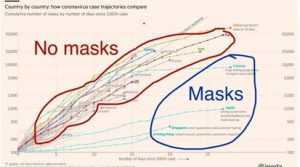 |
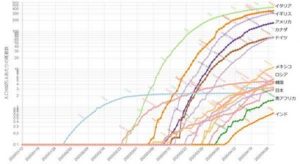 |
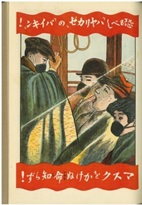 |
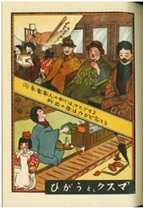 |
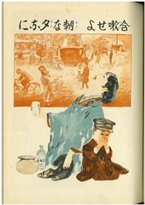 |
Gargle recommended poster (Taisho period)
Ministry of Home Affairs, Ministry of Health, “Record of epidemic cold “Spanish flu” epidemic” Heibonsha
In the history of the Heian period, “The Three generation records of Japan” (862), it was written as 「Many coughing illnesses occurred in the winter of January, resulting in more deaths」 Many people suffered from 「Coughing illness」 not only in Kyoto but almost all over the country, resulting in many deaths. It is considered to be the first influenza in Japan. It is said as 「There are rumors that there are many cough illnesses throughout Kyoto, and a poison from a Bokai guest」 that it was brought to Japan by the people of the present Tohoku region of Bohai, which is in the northeastern part of China. It was said like rumor at that age. It seems that the symptoms were spreaded from Kyoto. It is said that it was just three years after the Jogan earthquake.
Looking at the world, in 412 BC, the record of the flu was Hippocrates who was the father of medicine. It seems that M. tuberculosis was brought by a visitor in the third century of the late Yayoi period. However, it was about 100 years ago during the Taisho era that we were able to analyze epidemics. Prior to that, it seems to have assumed that there was an outbreak from symptoms that were probably influenza and tuberculosis.
It is said that the history of masks used when suffering from such infectious diseases begins in the Meiji era in Japan, but in fact, it has its roots in the shrines (Hire and shoulders) of the Heian era.
I thought that the scarf (slender cloth) called “Hire” written in “Nipponshoki” and “Kojiki” was taken from the era before BC, and when they found a snake or centipede, they waved Hirei and then living thing were gone out .
Looking at the picture of 「Ipen Priests Picture story」 「Beggar in front of gate」: The Beggar in front of the gate”, you can see that the masked beggar sits on the slope road of Kiyomizu-temple with wraped up white cloth to his mouth
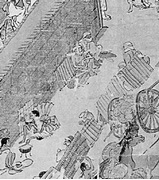 |
“Kyoto People’s Life History” CDI Edition
In the Heian period, it was believed that at that time, Hirei had the magical power to shake it to cause wind and drive away pests and poisonous snakes. Have you ever seen a picture called Tennyo no Hagoromo? It is a cloth that is stretched from left to right from neck to shoulder. Although it is a piece of cloth, they have believed that this cloth has the power to remove impurities.
Western scarves and scarves were used for cold weather, and bandages also played a role during the French Revolution, but the roots of Japan were to remove impurities.
Originally, masks were used in Europe around the 15th century as a muffler in Europe where a woman covered the lower half of her face with a white cloth. In the French Revolution, the muffler is said to have played a role as a bandage by wrapping a black cloth around the cheek around the neck.
Ikkyu Osho, which was used for cold weather in Japan, has a song written as “Erimaki : muffler” in the Muromachi period, and it seems that it was used for cold weather. Masks are used for cold weather in the Tohoku region of China. Colorful masks are lined up in stores as winter fashion items.
In the Edo era, the mask of measures against mining diseases at Iwami Ginzan can be said to be the root of the present mask.
Japanese masks are initially called “factory masks” and are made in the early Meiji era. Literally made as a dust guard during factory work. It was made of brass wire mesh with a cloth attached as a filter, but it did not spread in general because it would rust due to breathing. In the Meiji era, masks are worn at the treatment site for patients with infectious diseases.
In 1919, when a Spanish-flu caught a pandemic and it helped prevent colds, it broke into a boom and the supply could not catch up, leading to a rush of manufacturers, but in the Great Kanto Earthquake, it had been spreaded in well orderly manner.
Every time the flu spreads, masks become widespread, and in 1934, the pandemic of the flu caused an increase in the shipment of masks, and the gauze was used with triple or fourfold folding. It became the current shape/flat mask. It was in 1948 (Showa 23). In the 2000s thereafter, non-woven gauze became a non-woven fabric, and non-woven pleated type appeared. Demand for masks increased due to demand for pollinosis, SARS, new influenza and new coronavirus.
They had no habit of using masks in the West, but as you can see from the graph above, the effectiveness of masks has been proven. On April 3, 2020, President Trump announced a mask recommendation and the CDC (American Centers for Disease Control and Prevention) issued new guidelines recommending that you cover your face with a mask or cloth in public. Wearing masks and going out became the norm in both New York and Paris.
When the Spanish flu that had become popular 100 years ago, the “Mask Ordinance” was enforced in San Francisco, and it was mandatory for all citizens to wear a mask when going out. As learning in San Francisco, the mandatory of wearing mask was adopted in Europe.
Since April 10, 2020, Mayor Garsetti of the City of Los Angeles, U.S.A., has obliged employees such as grocery stores, pharmacies, hotels, and taxi drivers to wear masks as even at non-medical stores. Customers who shop at grocery stores out have announced that they cannot enter without a mask.
In addition, Governor Cuomo of New York announced on April 14 that it is mandatory to wear a mask in public places. In Japan as well, in Yamato City, Kanagawa Prefecture, with the aim of preventing the spread of new coronaviruses, Japan’s first mask wearing ordinance “Omoiyari Mask Wearing Ordinance” was established on April 16 and emphasized that it is effective in not infecting to others.
On April 14, the U.S. Embassy in Japan urged Americans in Japan to wear masks and go out in accordance with the instructions of each local government.
In addition, it was reported that Taiwan was the first to control corona infectious diseases, which leads to a history of completely changing hygiene habits such as wearing masks dating back to the era of Japanese rule 100 years ago. Taiwan, malaria, whooping cough, etc., which had many infectious diseases, in 1895, when he was owned by Taiwan, he was the director of Shinpei Goto’s health department. He recommended wearing a mask in Taiwan during the 1918 Spanish flu epidemic. It is said that this Spanish flu that was popular all over the world spread from 1918 to 1920 and worked hard on wearing masks.
In addition, Taiwan’s insurance card has been converted into an IC card, so it is distributed to all citizens. According to the proposal, 90% of mask production was imported from China, but now it is urgently produced in Taiwan.
There was no clear evidence of the effectiveness of the mask, but we used thermal fluid analysis software to visualize the sneeze droplets. According to the analysis results when the mouth was not covered at all and when the elbow was covered, when the mouth was not covered at all, the saliva droplets (fine particles) reached a position 2 meters away from the sneezing direction. On the other hand, when the mouth was covered with the elbow, the airflow of the sneeze split up and down with the elbow, and the reaching distance of the particles was about 1 meter. It has been found that wearing a mask does not allow the particles to fly forward. However, according to experts in the removal of fine particles in the semiconductor industry, 100 nanometer-sized particles are suspended in the air where there is no air flow, and a closed building with no air flow and vehicles are risky space same as droplet infection. There is a second risk. However, if there is an air flow, the particles will adhere to obstacles such as walls, floors, etc. and will not be detached unless physical force such as touching with hands is applied. The physical properties of the particles are posted on our Blog on March 15. If you can view it as well, you may be able to take convincing measures.
In France, where the curfew was eased on March 11th from 17th March, people are now obliged to wear a mask in public places and can move freely within 100km of their home. Initially, the French government’s policy was that there was no point in preventing infection, but it has changed. If you don’t wear a mask when using public transport, you will be fined 135 euros (about 16,000 yen). The difference between the Japanese sense of resistance to the mask and the Western sense became clear.
Also, on May 17, the University of Hong Kong announced in a hamster experiment that wearing a mask is effective in preventing infection with this new coronavirus. It’s no wonder that in Hong Kong, which has a population of 7.5 million people, people called for wearing masks from the early days of the epidemic, and the number of infected people was about 1,000 and the number of dead was four. I was convinced well.
The end of document
